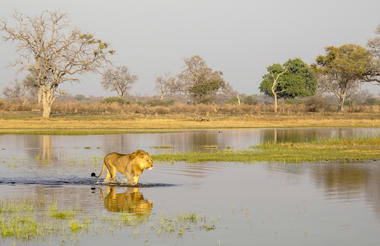With its well-developed infrastructure, some of the best tourist facilities in Africa and an impressive list of breathtaking natural wonders, touring Namibia is truly a pleasure. Visit the capital of Windhoek and the lovely coastal town of Swakopmund to discover remnants of the country’s German influence, reflected in the architecture, culture, cuisine and the annual Oktoberfest celebrations. To properly appreciate this extraordinary country, you will have to venture out of the cities to explore the remarkable natural landscapes Namibia has to offer. These include: the impressive Fish River Canyon Park; the vast Etosha National Park teeming with local subspecies, such as desert lions, desert elephants and the Hartmann's Mountain Zebra; the hauntingly beautiful Kalahari Desert; and of course the Namib Desert stretching for nearly 1000 km along the magnificent Atlantic coastline. Namibia is an ideal destination for travellers seeking an unforgettable African experience in a uniquely beautiful untamed wilderness.
Etosha National Park in the central north is world-famous for its abundance of wildlife and premiere game viewing opportunities. The park is home to 114 species of mammals, including elephants, black rhinos, lions and other big cats and predators, giraffes, various antelopes and zebras, as well as hundreds of species of birds and reptiles. The vegetation ranges from dense bush to open plains with semi-arid savannah grasslands. During the dry season and in times of drought, the animals flock to the perennial springs and artificial waterholes which are maintained all over the park.
Etosha Pan in the heart of the nature reserve is a vast shallow depression of 5000 kilometres2 that can even be seen from space. The huge salt pan is dry for most of the year and lies shimmering in the heat, but after good rains it fills up with water and attracts scores of birds, especially flamingos from as far away as the Walvis Bay Lagoon on the Atlantic coast.
The western reaches of Etosha are quite different from its south-eastern and eastern parts. Even the characteristic white dust of the pan gives way to reddish-brown soil. The hills of western Etosha are the realm of Hartmann’s Mountain Zebra.
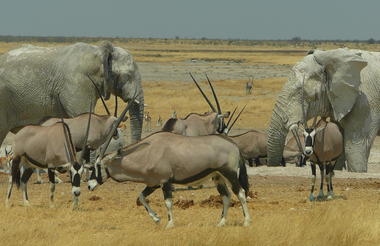
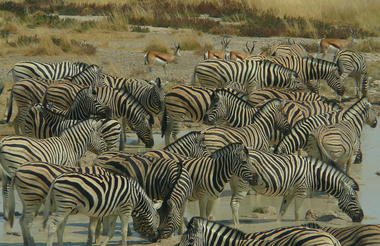
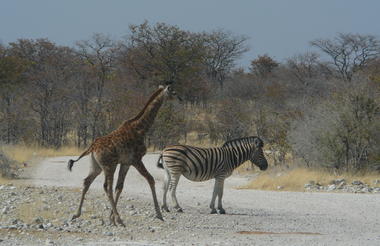
In most places in the park, the pans are devoid of vegetation with the exception of halophytic Sporobolus salsus, a protein-rich grass that is eaten by grazers like blue wildebeest and springbok. The areas around the Etosha pan also have other halophytic vegetation including grasses like Sporobolus spicatus and Odyssea paucinervis, as well as shrubs like Suaeda articulata. Most of the park is savanna woodlands except for areas close to the pan. Mopane is the most common tree, estimated to be around 80% of all trees in the park. The sandveld of north-eastern corner of Etosha is dominated by acacia and Terminalia trees. Tamboti trees characterize the woodlands south of the sandveld. Dwarf shrub savanna occurs areas close to the pan and is home to several small shrubs including a halophytic succulent Salsola etoshensis. Thorn bush savanna occurs close to the pan on limestone and alkaline soils and is dominated by acacia species such as Acacia nebrownii, Acacia luederitzii, Acacia melliferra, Acacia hebeclada and Acacia tortilis. Grasslands in the park are mainly around the Etosha pan where the soil is sandy. Depending on the soil and the effects of the pan, grasslands could be dominated by one of the Eragrostis, Sporobolus, Monelytrum, Odyssea or Enneapogon species.
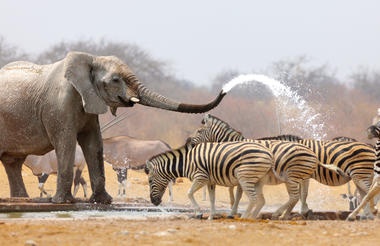
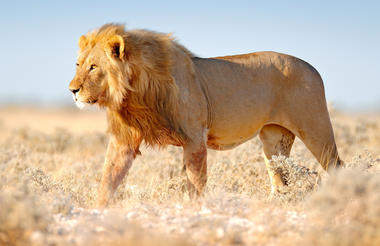
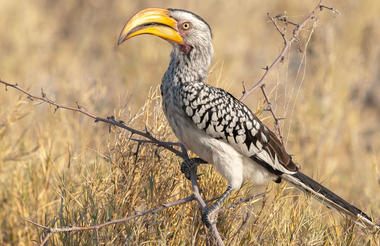
The Okavango River is the fourth-largest river system in southern Africa. From its source in Angola it runs south-eastward into Namibia and forms part of the border between Namibia and Angola. Just before it flows into Botswana and empties into the Okavango Delta, the river cascades over the Popa Falls, dropping four metres over a series of rapids.
The city of Rundu on the banks of the Okavango is the capital of Kavango-East, a region known for its lush vegetation, spectacular natural beauty, abundant wildlife and some 400 species of birds. With 150 species of fish the river is a popular fishing destination.
Activities: Take a scenic boat cruise; go birding; visit the nature reserves in this region; see the Popa Falls; explore Rundu.


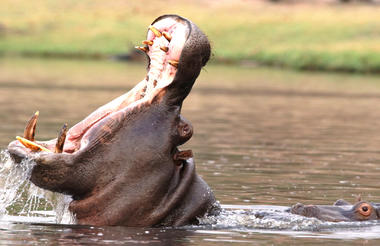
Meandering through the spectacular Zambezi Region in north-western Namibia, the Kwando River forms the border between Namibia and Botswana near the end of its course. The area along the Kwando is known for the game reserves, national parks and wildlife sanctuaries which offer excellent game viewing opportunities. The perennial river attracts plenty of wildlife – large herds of elephants, hippos, crocodiles, turtles, spotted-necked otters, zebra, impala and red lechwe, to name but a few, as well as more than 400 bird species. Accommodation is provided by numerous lodges on the banks of the river.
Activities: Game viewing; bird watching; river cruising; fishing; go camping; relax and soak up the spectacular views of wild Africa.



The Chobe River forms the northern boundary of the Chobe National Park which is renowned for its diverse and abundant game viewing opportunities. This section of the park is best known for its dense concentration of wildlife, including elephant and hippo populations, but the waters attract all manner of game including large herds of buffalo and the lions that prey on them - a visit to the Chobe River Front guarantees close encounters with an array of African wildlife. Visitors can look forward to a range of exciting activities such as 4WD along the banks; motorboat cruises; and rare birdlife spotting. For a unique, luxury safari experience, hire a houseboat.



The Zambezi Region, previously known as the Caprivi Strip, is Namibia’s “panhandle” that juts out eastwards between Angola and Botswana all the way to Zimbabwe. Its easternmost tip is the only spot on the planet where four countries meet. The Zambezi Region lies in the middle of one of Africa’s largest and best-known game-viewing areas. It is part of the Kavango-Zambezi Transfrontier Conservation Area (KAZA), which combines 36 game reserves in Namibia, Angola, Zambia, Botswana and Zimbabwe. Since there are no fences, animals can move freely between the neighbouring countries. The abundance of water supplied by the Zambezi, Okavango, Kwando and Chobe rivers sustains a large variety of animal and bird species.
Activities: Enjoy manifold game-viewing opportunities; go bird watching; go angling for tigerfish in the Zambezi River; join river cruises; soak up the natural splendour of this scenic region.



As previously described
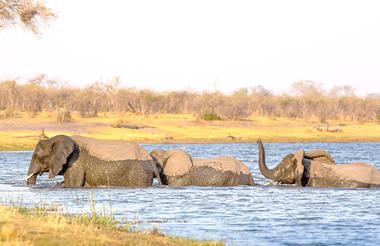


As previously described
